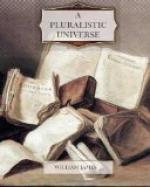We of course need a stable scheme of concepts, stably related with one another, to lay hold of our experiences and to co-ordinate them withal. When an experience comes with sufficient saliency to stand out, we keep the thought of it for future use, and store it in our conceptual system. What does not of itself stand out, we learn to cut out; so the system grows completer, and new reality, as it comes, gets named after and conceptually strung upon this or that element of it which we have already established. The immutability of such an abstract system is its great practical merit; the same identical terms and relations in it can always be recovered and referred to—change itself is just such an unalterable concept. But all these abstract concepts are but as flowers gathered, they are only moments dipped out from the stream of time, snap-shots taken, as by a kinetoscopic camera, at a life that in its original coming is continuous. Useful as they are as samples of the garden, or to re-enter the stream with, or to insert in our revolving lantern, they have no value but these practical values. You cannot explain by them what makes any single phenomenon be or go—you merely dot out the path of appearances which it traverses. For you cannot make continuous being out of discontinuities, and your concepts are discontinuous. The stages into which you analyze a change are states, the change itself goes on between them. It lies along their intervals, inhabits what your definition fails to gather up, and thus eludes conceptual explanation altogether.
‘When the mathematician,’ Bergson writes, ’calculates the state of a system at the end of a time t, nothing need prevent him from supposing that betweenwhiles the universe vanishes, in order suddenly to appear again at the due moment in the new configuration. It is only the t-th moment that counts—that which flows throughout the intervals, namely real time, plays no part in his calculation.... In short, the world on which the mathematician operates is a world which dies and is born anew at every instant, like the world which Descartes thought of when he spoke of a continued creation.’ To know adequately what really happens we ought, Bergson insists, to see into the intervals, but the mathematician sees only their extremities. He fixes only a few results, he dots a curve and then interpolates, he substitutes a tracing for a reality.
This being so undeniably the case, the history of the way in which philosophy has dealt with it is curious. The ruling tradition in philosophy has always been the platonic and aristotelian belief that fixity is a nobler and worthier thing than change. Reality must be one and unalterable. Concepts, being themselves fixities, agree best with this fixed nature of truth, so that for any knowledge of ours to be quite true it must be knowledge by universal concepts rather than by particular experiences, for these notoriously




